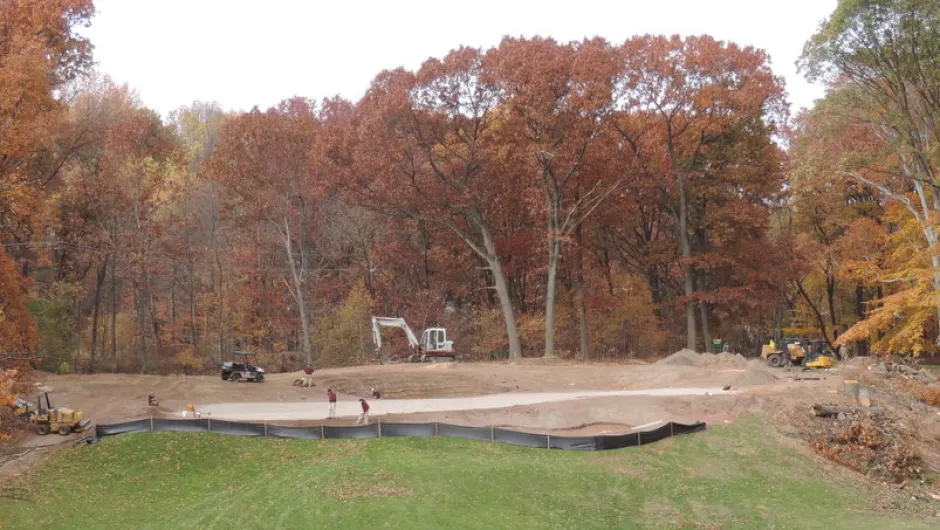Galloping Hill Renovating Tees, Greens & Bunkers

Just three weeks after the official transformation of Galloping Hill Golf Course in preparation for the 2016 NJSGA State Open was announced by the Union County Board of Freeholders and KemperSports, serious work was well under way.
The golf course is being renovated by architect Rees Jones and his team over the course of the next six to eight months with the addition of at least 10 new championship tees, new drainage and two new green complexes on the fifth and 16th holes.
The New Jersey State Golf Association, the second oldest state golf association in the U.S., had long considered bringing the state’s biggest golf tournament to a public course.
Beginning on October 15, the front nine of the 18-hole golf course is closed for renovations for the winter.
By November 6, many trees had been removed; work was near completion at tee boxes on the sixth, 10th, 11th, 14th and 17th holes and construction on greens at the fifth and 16th holes was well along.
In addition, seven new bunkers are being installed on the course to increase the total to 54.
Golf course architect Rees Jones, nicknamed “The Open Doctor,” is renowned for his work on prominent U.S. Open and major championship courses, such as Bethpage State Park’s Black Course, Hazeltine National, Medinah Country Club, East Lake Country Club, and Congressional Country Club, among others.
Jones’s redesign at Galloping Hill will stretch the existing 6,700-yard layout to nearly 7,000 yards while restoring some of the original shot values and sight lines from Willard Wilkinson’s initial plans. Steve Weisser, a vice president at Rees Jones, is the project manager.
“We’re adding yardage, working on tees, greens and bunkers to provide our golfers with a golf course better than expected,” said course superintendent Russ Harris. “Galloping Hill is not your typical municipal golf course.”
The fairway on the par-4, 379-yard fourth hole has had two of its three bunkers reangled and repositioned. The third bunker was removed and replaced by fairway sod.
On the par-3, 150-yard fifth hole, both the tee and the green are being reconstructed. The tee was relocated to the right and 200 square feet were added to it.
The green was lowered three feet and trees were removed around it to allow for more sunshine. Two bunkers were added, front right and behind, and the green is 2,000 square feet larger.
“It was the weakest green on the course,” Harris said. “There’s always been a moisture issue there and no air movement. Having minimal sunlight and 40,000 rounds per year played on it also didn’t help.”
The two rear tees at the sixth hole, a par-5, 559-yard hole, were shifted right and internal drainage was added.
A new rear tee box on the par-4, 395-yard 10th hole angles to the left and away from the Garden State Parkway. It also adds 20 yards in distance.
At the par-3, 190-yard 11th hole, a new rear tee was also added, giving the hole 30 more yards in length. It was cut into an existing hill.
“Once it became official that Galloping Hill would be host for the State Open, we knew we needed to add additional yardage,” Harris said. “We will be adding 200 yards, which will get us close to 7,000 yards. We don’t need to be 7,200 yards. The greens will more than make up for that. The greens will protect against low scores, that and the elevation changes.”
At the par-4, 400-yard 14th hole, a new tee box was added, enabling the hole to gain 35 yards in distance. The new tee was constructed on top of fill dirt.
Some 1,700 square feet were added to the 16th green, which concludes a par-4, 408-yard hole. A right front bunker was added and the grass was changed from poa annua to bent grass, which can better tolerate the heat of summer.
The 17th tee, the starting place on the par-4, 319-yard hole, was moved from left to right and increased in size by 800 square feet.
“I’ve been working here, pretty much on and off, since 1995,” said Harris, a graduate of Rutgers University’s golf turf management program. “I came in for the second phase of the original renovation by Stephen Kay. I started playing here when I was 11 years old, so this place means a lot to me.”
